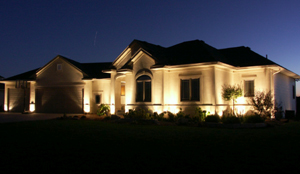About Our Lighting Design
When it comes to lighting your landscape, a little goes a long way. The Knockout Landscape Lighting Team in Mt Pleasant and Charleston SC is always there for you because your eyes need less light outdoors than they do indoors in order to see light, shadow, and pattern. To plan your landscape lighting, walk around your yard at night, envision how and when you want to use your spaces, and rely on these tips.
The Basics
How light is seen during the day is different from how it is seen at night, a particularly important distinction when it comes to lighting pathways and other outdoor spaces. However, certain principles about lighting remain true.
For starters, light has the intensity, or quantity emitted. The color of a particular light bulb can be found on the packaging; it is a number that ranges from 1800 kelvins (K), which is very red in tone, to 7500 K, which is a bluish-white.
Whether indoors or outdoors, lighting is generally divided into three layers based on function.
- Overall: Overall light provides illumination for a whole room or space.
- Task: Task lighting is used for a specific purpose, such as to light a path.
- Accent: Accent lighting draws attention to an object or area. This is usually accomplished with spotlights or floodlights.
A variety of bulbs are suitable for outdoor fixtures. Incandescent bulbs emit pleasing light but have a short life and consume more electricity. Halogen bulbs are more efficient versions of incandescent, typically with a longer life and less energy consumption. Fluorescents are now available in a more pleasing color range, last much longer, and consume less energy. While LED bulbs are more expensive, their costs — which continue to decline — are balanced by their extraordinarily long life and extremely low energy consumption.
Landscape lights that are located near a building with electricity can easily be integrated into your home’s wiring system.
Outdoor Lighting Issues
Outdoor lighting issues differ from those of indoor light. For example, reflection is less an issue outdoors because most surfaces are dark and do not reflect light well. However, position and shielding are more important in outdoor landscape lighting in order to prevent glare.
Glare happens when a light source is too big or too bright; it can be blinding because it reflects directly in people’s eyes. Exterior landscape lighting also needs to be particularly sensitive to direct versus indirect light. Direct outdoor landscape light, such as a down light outside a side entry door, will brighten mostly the object it is directed at and little of the surroundings. Indirect light reflects on the surrounding surfaces to create a soft wash.
Architectural Features: Outdoor landscape lighting can be used to highlight a wall, for example, by washing it or grazing it. When a wide beam of light is aimed at a wall from a few feet away, it creates a wall wash. A light used to graze a wall creates interesting highlights and shadows. Both will provide a little accent to nearby plants.
Outdoor Light Pollution
Too much light, or poorly installed lighting, can create unwanted light pollution that shines into indoor rooms, washes out the view of the stars, creates glare that temporarily blinds people, and wastes energy and money. To avoid light pollution:

